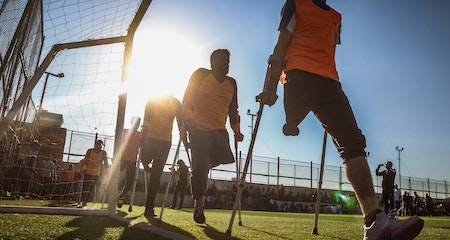Exercise is essential for everyone, but it can be especially important if you have a disability. It can help keep your body strong, provide you with energy and improve your mood and stress levels.
It also may help reduce your risk of heart disease, high blood pressure and obesity. You can find many different ways to exercise with a disability, as long as you work with a doctor or physical therapist to determine what is right for your needs.
Walking
Walking is a gentle way to get active and has many benefits for adults with a disability. Walking can improve mood, prevent illness, and lower your risk of developing heart disease.
People who walk at least 30 minutes a day have a 30% reduced risk of heart attack or stroke. Research has also shown that brisk walking is associated with a lower risk for dementia and death.
Walking is an excellent form of exercise, as long as it’s done regularly and at an intensity that’s manageable but slightly pushes your comfort zone. As you gain strength, you can gradually increase your walking distance and time.
Swimming
Swimming is a great way to exercise with a disability. It offers many benefits, both physical and emotional. It improves heart and lung health, increases muscle strength and flexibility, and reduces stress on the body.
It also helps those with disabilities maintain a healthy weight. According to the President’s Council on Health, Fitness and Nutrition, obesity rates for children with disabilities are 38% higher than for those without disabilities.
The buoyancy of water also helps to relieve the pressure gravity places on joints, muscles, and joints. This can help people with disabilities like spina bifida and cerebral palsy to feel more comfortable moving their bodies, even when they’re confined to a wheelchair or walker.
Water Aerobics
Water aerobics is a great way of increasing your heart rate and muscle strength. It’s a low-impact workout that anyone can do.
A typical class involves a warm-up, cardio and strength training exercises, and a cool down. Flutter kicking, water walking and leg lifts are some of the movements you’ll do.
In some cases, you might use props to add resistance such as webbed gloves or ankle weights. This makes your workouts even more challenging, increasing muscle tone and endurance.
Exercise in the water can also help relieve arthritis pain. This is especially beneficial if you have knee or joint problems.
Read Also : Sonic Lunch Hours
Water Running
If you’re looking for a low-impact way to get your cardio fix, water running is the way to go. The buoyancy of the water, combined with the resistance it provides, makes this exercise feel challenging and rewarding at the same time.
According to research, this activity also helps strengthen muscles. Because water’s viscosity slows your movement than on land, this activity forces more muscle work to keep you moving.

For people with spinal injuries, chronic pain, osteoporosis or arthritis, water running can help provide relief and increase overall fitness. Water running can help relieve or prevent pain and inflammation by reducing pressure on the spine.
Water T’ai Chi
Water t’ai-chi (also known by Ai Chi) can be a gentle form or exercise that can aid people with disabilities. It combines deep breathing and slow, broad movements in shoulder-depth water to promote relaxation, reduce pain, improve range of motion, balance and mobility.disability services melbourne
Ai Chi has also been shown to be effective for older adults, including those with multiple sclerosis or Parkinson’s disease. A study published in Neuro Rehabilitation showed that 23 women with multiple sclerosis experienced improvements in their muscle strength and mobility after 12 weeks of Ai Chi.
Research has also demonstrated that water t’ai chi helps reduce back pain in patients with chronic low back pain. After 10 weeks of Tai Chi, participants experienced significant back pain relief.




